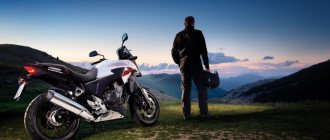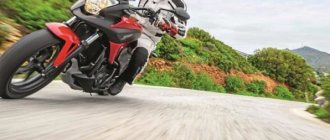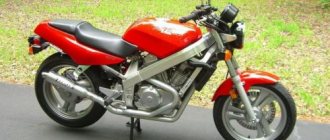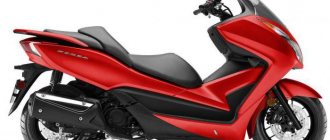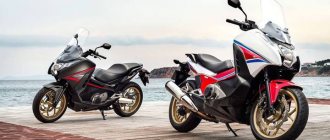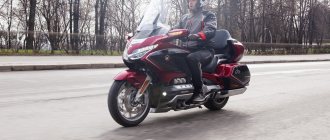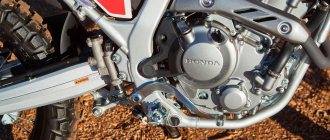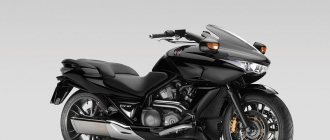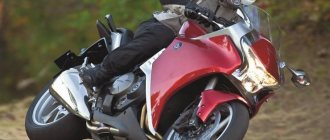- motorcycle model, brand Honda
Honda CB1100 Honda CB1100EX
The model of the classic motorcycle Honda CB 1100 was introduced in 2010 as a modern replacement for the Honda CB 750 model and a continuation of the old version Honda CB 1100 F. Since 2010, the motorcycle has been officially sold in the markets of Japan, Australia and New Zealand, and since 2013 it has become available in Europe and the USA.
The Honda CB 1100 model was based on an in-line 4-cylinder air-oil-cooled engine with a capacity of 1140 cc. see, producing about 90 hp. power and 91-93 Nm of torque. Maximum performance - at 5000-7500 rpm.
The model is distinguished by a classic steel tubular frame, simple suspension in the form of a telescopic fork and a double shock absorber at the rear, disc brakes, the availability of versions with ABS and the classic shape of a motorcycle from the 80s of the last century.
Main modifications of the Honda CB 1100
Honda CB 1100 - regular version.
Honda CB 1100 DLX (Deluxe) - available since 2014. Based on the 2nd generation CB1100. It features a larger fuel tank (16.8 liters), 4-into-2 exhaust, ABS, a different seat and some other details.
Honda CB 1100 EX - available since 2014. Based on the Deluxe (DLX) modification, but differs in spoked wheels.
Honda CB 1100 RS - available from 2022. It features new rims, 120 and 180 mm tires, LED optics, a wheelbase shortened by 5 mm, new suspensions (43 mm fork, Showa rear shock absorbers with remote reservoirs; gold color), new Tokico brakes with radial calipers and larger discs diameter (310 mm).
conclusions
If we evaluate these motorcycles from the position of “purchase for centuries” for their use specifically as a vehicle, then Honda will have an advantage due to more thoughtful ergonomics, smoothness of the engine, comfortable suspension and greater versatility, allowing you to ride around the city every day, and go on a long journey. You can spend 12–14 hours without a break behind the wheel of a Japanese motorcycle and travel one and a half thousand kilometers from home in a day.
BMW is not so merciful in this regard - its driving position is more tense, and the seat is so comfortable, and it itself is more twitchy and rigid, which makes it more tiring on a long journey. Its element is driving in the city and near suburbs, where its sharpness in acceleration and trajectory changes will encourage you to drive aggressively and quickly.
From an image point of view, Honda has high value only in its home country, while BMW has high value throughout the world. If you care about the opinions of others, then it is better to choose BMW. There are still people alive who remember the “economic miracle” of Japan, which after World War II flooded the whole world with cheap goods of dubious quality. After it, South Korea did roughly the same thing, and now China is doing it with all its might. Can we talk about the legendary nature of Geely or Great Wall cars? Definitely not yet, and many years must pass until the “no” is replaced by a definite “yes”, and then only with the constant impeccable reputation of their products. Honda's reputation is fine, but BMW is older and actually stood at the origins of European motorcycling.
As you can see, there are enough differences between these bikes to make your choice easier. You need to grow into the paradigm of long-term use of a vehicle and then decide what suits you best in terms of design, brand and feelings awakened in your soul, and also take into account your style of behavior on the road.
The BMW motorcycle was provided for testing by the BMW Motorrad representative office in Russia.
www.bmw-motorrad.ru Honda motorcycle provided for testing: www.honda.co.ru/motorcycles Tverdynya > February 1, 2019 08:40 Denis DEAN Panferov
Main generations of Honda CB 1100
Honda CB1100 (2010-2013) - first generation. The model has a 5-speed gearbox, 248 kg curb weight, is available in only one modification (+ version with ABS) and is sold mainly in the Japanese and Oceanian markets (Australia, New Zealand).
Honda CB1100 (2014+) - second generation. The model receives a 6-speed gearbox and + 3 new versions (EX, DLX, RS - from 2022). From this generation, the model is also available on the North American and European markets.
Honda CB1100DLX (Deluxe) Honda CB1100RS
Is it possible to stop time? This question cannot be answered unambiguously. On the one hand, we have the inviolable laws of physics that clearly prohibit stopping the passage of time. On the other hand, in addition to all the quantum exoticism that does not prohibit time travel, we have museums that store samples and artifacts of a particular era, and human imagination can immerse us in almost any era. Many people devote themselves to studying and reconstructing past times in order to immerse other people in them. So the question about time travel is more like this: how difficult is it to experience yourself in another time? The answer is individual and depends on imagination, but imagination can already be helped by creating the appropriate environment and atmosphere.
Today I offer you, my dear reader, a small immersion into the atmosphere of days gone by. And let me tell you a little about where we will dive, create the appropriate atmosphere, so to speak.
So, the 70s of the 20th century. A generation of people has matured who only heard about the hysterical wail of an air raid siren and the crackle of machine gun fire from the stories of the older generation. Yes, there are enough tense points in the world, there is a “cold war”, and, as its hottest manifestation, the war in Vietnam. But the generation of the 70s was tired of wars and conflicts, tired of having to survive and not live. This resulted in the 70s becoming a time of “freedom”. The younger generation decided to go beyond the boundaries, self-expression became a kind of icon. Many have delved deeper into understanding themselves and their place in this world. Each social, cultural or subcultural group created its own style and way of life, and, like icing on the cake, the firm tread of the sexual revolution, heavily implicated in the availability of psychotropic substances. And this was in almost everything: in music, in painting, in architecture, in design. Yes, even, damn it, in cooking!
Well, what about motorcycles? Well, motorcycles of the 70s era were also quite diverse. Cruisers, or motorcycles for tourism, have already begun to acquire panniers and fairings, and choppers have fixed their canonical appearance. However, for the most part, these were the same “classic” devices, outwardly not very far removed from a bicycle without pedals, but with an engine. Sports motorcycles are also a little behind them. Yes, the obvious advantages of aerodynamics perched cockpit-like fairings on the front and forced the pilot to take a rather strange pose, but still, they are far from modern, precise aerodynamic forms. Compared to aviation, these were no longer bulky multiplanes made of wood and fabric with braces on the wings, but the F-117 Night Hawk was still far away.
Civilian versions of sports motorcycles (although here it is impossible to say for sure what was primary and what was built from what - sports motorcycles from civilian ones or, on the contrary, civilian ones created on the basis of racing versions, it will not work, but this does not change the essence) were changed mainly by removing the fairings , and the return of such parts that are not needed in motorsports, such as headlights and turn signals. However, this was a very successful marketing ploy - the client saw an athlete at the races, dashing along the track on a motorcycle almost the same as the one on which he himself arrived. It gave a feeling of belonging. Such motorcycles, which looked like their sports counterparts, began to be called superbikes (SuperBike). And this, in itself, gave birth to a new fashion and a new subculture. The seeds of a superbike fell into the very fertile soil of Cafe Racers, they were a kind of stimulus for development and reborn cafe racers into street fighters. In essence, nothing has changed: the same strong guys in leather jackets, representatives of the “working youth,” so to speak. They, just like in the 50s and 60s, rushed along the roads to show off their brave prowess, entered into conflicts with government officials, and had “tender” relationships with other subcultures. In general, a kind of stereotypically romanticized image of a “bad guy” on a noisy, dirty, but damn fast motorcycle.
And now that, I hope, I have created the necessary atmosphere of creative madness with lysergic ponies to the sounds of disco and the roar of heavy engines, I will still move on to our today’s hero: the Honda CB1100RS - a classic superbike of the 70s, a little more than completely.
Well, here it must be said that all the signs of “that same superbike” are observed exactly. Duplex frame made of steel pipes, cast wheels (in the EX version the wheels are spoked, which is somewhat closer to civilian technology of those years), air-oil-cooled engine, chrome-plated exhaust pipes on both sides of the motorcycle, rounded double saddle, direct fit, round headlight and a simple brake light placed on the wing. A minimum of decorative and other unnecessary details, and a maximum of load-bearing elements on display. It would seem that everything is simple and banal, and, in general, even ordinary, but the devil, as we know, is in the details.
Let's start with the fit and ergonomics. The seat looks quite simple, an ordinary two-seater “sofa”, with only a nominal hint of a “step”, which should mean poor support for the fifth point. But when you sit on this seat, it is pressed down somewhat, and the emphasis becomes very noticeable, which significantly adds to comfort. The legs habitually find the footrests, the hands find the handles themselves, the fingers precisely fall on the levers, all movements and positions are on an intuitive level, classic. In general, the ergonomics suggest some forward lean, making the riding position moderately aggressive, but not so much that it is noticeable. The remote controls on the steering wheel, by the way, are ascetic, one might even say rustic, the range of functions is minimal, but everything is at hand and there is nothing superfluous. You definitely won't get lost in the buttons.
The chassis is also not overly complex: a steel spine made of pipes, a tank on it, a motor under the tank, two wheels, two front seats, two shock absorbers at the rear, disc brakes - that’s, in fact, the whole simple set. But all together it gives amazing maneuverability. Rigid frame, front suspension, although not a newfangled “changeover”, but quite modern, rear shock absorbers of a backpack type, everything is from Showa and most likely corresponds to the 21st century. A minimal, but still sufficient, set of suspension adjustments, tenacious brakes with ABS and excellent feedback, all this together makes the motorcycle quite nimble, even aggressive. It takes turns with great pleasure; it moves along the trajectory like a locomotive on rails, no wobbling, yawing, drifting or wobbling. Only the considerable mass of all these cast iron, and not aluminum, parts makes control, let’s say, physically necessary. That is, in order to do something, you need to do it with your hands and body, demonstrate your will clearly, make an effort. But if you are a real man, and not a “slim young man with glasses,” you are unlikely to even notice the efforts being made, and the need to express your desires so specifically will be more likely to be a pleasure. Maneuvering in city traffic is also not satisfactory. The low center of gravity and almost upright seating position make the ride not just comfortable, but I would even say provocative.
Now a little about the exterior. The appearance is simple, but at the same time exemplarily stylish, within the framework of its era, of course. An equal mix of chrome, polished and black, rough-looking details creates the necessary aesthetics. All elements combine perfectly with each other, emphasizing a strict retro sporty style, nothing superfluous, everything to the point. But even here there are some inclusions of modernity. I'll start with the headlight. The round classic headlight is located and fixed on the traverses, everything, it would seem, is within the canon. But the optics inside are LED, with an abundance of lenses, which is somewhat confusing and clearly does not fit into classical concepts, although it does not spoil the overall impression. And given that even outside the city, on a deep moonless night, this optics does its job, perfectly illuminating the trajectory, then this is, perhaps, a feature, not a bug. The dashboard deserves a separate story. She really stuck with me. Two dial wells for speedometer and tachometer. Between them is a small LCD display, with white numbers on a dark blue background, the central place of which is occupied by the gear indicator. Indicator icons light up only when needed, the rest of the time they blend into the background. All this is crowned with an almost sexy soft white backlight. It just makes me shiver how tasty, juicy and beautiful it is. The information content of this dashboard is exactly at the required level, a sufficient minimum, period. I think there is no point in saying too much that the readability of instruments in any road conditions and in any lighting conditions is more than excellent. The only thing left to mention is the rear light, also known as the brake light, which doesn’t stand out with anything special here except for its LED filling. But visually it fits so organically into the image of the motorcycle that it is taken for granted and would most likely raise questions if it were anything else.
Well, now let's move on to the fiery heart. And here I was disappointed. 90 horsepower and 91 Nm of torque are infinitesimal for an engine with a volume of 1100 cubic centimeters. This is so small that it does not even cause irritation or anger, but sadness and melancholy. All the manufacturer's claims that they were inspired by the superbikes of the 70s are crushed by these characteristics. Yes, it looks and feels like a 70's bike, and for a 70's motorcycle this engine output is also quite good. But, damn it, we live in the 21st century, and from a motorcycle positioned as a racing motorcycle, even adjusted for the retro prefix, you expect something completely different. Yes, you don’t expect dynamic characteristics from it at the level of a modern sportbike, but you do expect some spice, aggression, a kind of strong, lively old man. Yes, the youth, of course, cannot be caught up, but the bones are strong, the eyes and heart are fiery, and the spirit is ardent, and that means the youth will not go far. What do we have instead? Instead, we have a museum piece, a flask of time, so to speak. A 70s superbike in every sense of the word. Yes, in the 70s they knew how to make fast motorcycles, but they were fast in the 70s, but today they are...
Against this background, all previous inclusions of modernity look truly inappropriate. If you create a museum, one might say, bench copy of a motorcycle from the 70s, then you could limit yourself to ABS (which is now a mandatory safety element and the production of vehicles without it is simply prohibited by law in many countries) and fuel injection, visually stylizing it as carburetors. Why this electronics, why lensed optics? We are creating a museum exhibit! On the other hand, if a modern motorcycle was created, stylized, both aesthetically and spiritually, according to the samples of the 70s, then where the hell is the spirit of the 70s? This motorcycle simply destroyed the spirit of that time, its aesthetics and eclecticism. Instead of a lively, strong old man, we got a flabby athlete who, for some unknown reason, had his face lifted and rejuvenated. It looks ridiculous.
The most offensive thing about this is that this motorcycle could be completely different. By adding everything-nothing 20-25 hp, and with the current degree of “boost” of the 1100 cc engine, this is not only possible, but will not even be difficult (BMW takes 200 hp from an engine with a volume of 100 cc less), and the motorcycle will be transformed beyond recognition . The ugly duckling will overnight turn into, not just a swan, a hawk, perhaps an elderly one, but still a hawk. Moreover, the rigidity of the frame and suspension, as well as the tenacity of the brakes, clearly indicate that the motorcycle was supposed to be completely different, or that the Japanese do not know how to design motorcycles. Somehow I don’t really believe the latter.
Riding this motorcycle is a lot of fun until you start to run into a lack of power. There is more than enough power for walking around the city in the evening from cafe to cafe. But anything more is not very good. Yes, the 1100 cc engine is very elastic, the main epithet that characterizes it is viscous. Like all in-line classics, it pulls, pulls, and pulls again, but due to the lack of this same traction, it has to be turned, and as a result, click the gears, but this still does not save... The notorious viscosity of large low-speed in-line engines, and the 1100 cc engine with a red zone starting at 8500 rpm - this is precisely a large low-speed rower that should envelop, envelop. The dynamics of this motorcycle should be similar to the dynamics of a locomotive - unhurried, but also inevitable. And I have something to compare with. At one time I rode a Honda CB1000 Big One from 1995. But there was 100 cubic meters less volume, and at the same time almost 100 hp and the same 90 Nm of torque. It felt completely different, it felt exactly like a diesel locomotive on takeoff.
And on this slightly minor note, I want to end my story. Finally, I would like to say that I liked the motorcycle. Yes, yes, I really liked it. Despite everything, it really is that sealed flask of time that will allow its owner to feel like in the era of the 70s, where disco and bright colors rule, where no creativity is persecuted (although, perhaps, it is condemned by someone). True, this flask still needs to be opened. If you like classic motorcycles, but don't want a museum display piece to put under glass and blow off the dust, but want to ride it every day, then this is definitely your choice. Yes, this motorcycle has a big drawback, but if your hands grow from the right place, and I am sure of you, then this will not become any obstacle for you. Well, if you are too busy to do it yourself, write to me, I will fix everything, not for free, of course, but I think we can agree)
So I take my leave. Thanks for reading. Always to yours Shtradman.
Main generations of Honda CB 1100
| Model | Honda CB1100 (CB1100EX, CB1100DLX, CB1100RS) |
| Motorcycle type | classic |
| Year of issue | 2010+ |
| Frame | steel duplex |
| engine's type | 4-cylinder, 4-stroke, in-line |
| Working volume | 1140 cc cm. |
| Bore/Stroke | 73.5 x 67.2 mm |
| Compression ratio | 9,5:1 |
| Cooling | air-oil |
| Number of valves per cylinder | DOHC, 4 valves per cylinder |
| Fuel supply system | electronic injection (PGM-FI) |
| Ignition type | transistor |
| Maximum power | 89.7 hp at 7500 rpm |
| Maximum torque | 91 Nm at 5500 rpm - CB1100EX, CB1100RS, CB1100 (2010-2013) 93 Nm at 5000 rpm - CB1100 (2014+) |
| Transmission | 5-speed - CB1100 (2010-2013) 6-speed - CB1100 (2014+) |
| type of drive | chain |
| Front tire size | 110/80R18 M/C 58V – CB1100, EX, DLX, Deluxe 120/70ZR17 M/C 58V – CB1100RS |
| Rear tire size | 140/70R18 M/C 67V – CB1100, EX, DLX, Deluxe 180/55ZR17 M/C 73W – CB1100RS |
| Front brakes | 2 discs, 296 mm, 4-piston calipers (ABS) - CB1100, EX, DLX, Deluxe 2 discs, 310 mm, 4-piston radial calipers (ABS) - CB1100RS |
| Rear brakes | 1 disc, 256 mm, 2-piston caliper (ABS) |
| Front suspension | 41 mm telescopic fork (adjustable preload), travel - 106 mm - CB1100 / EX / DLX 43 mm telescopic fork (adjustable preload) - CB1100RS |
| Rear suspension | pendulum with two shock absorbers (preload adjustable), stroke - 114 mm - CB1100 / EX / DLX pendulum with two Showa shock absorbers with remote reservoirs (preload adjustable) - CB1100RS |
| Maximum speed | 220.0 km/h |
| Acceleration to 100 km/h | 3.7 sec |
| Gas tank capacity | 16.8 l - CB1100EX, CB1100RS, CB1100DLX (Deluxe) 14.6 l - CB1100 |
| Length x Width x Height | 2200 (2205 - DLX) x 830 x 1130 mm - CB1100EX, CB1100 / DLX / Deluxe 2180 x 800 x 1100 mm - CB1100RS |
| Seat height | 780 mm - CB1100 / EX 765 mm - CB1100DLX (Deluxe) 785 mm - CB1100RS |
| Wheelbase | 1490 mm - CB1100EX, CB1100 / DLX / Deluxe 1485 mm - CB1100RS |
| Motorcycle weight (curb) | 248 kg - CB1100 (2010-2013) 252 kg - CB1100 (2014+) / DLX / Deluxe / CB1100RS 255 kg - CB1100EX |
BMW R NineT Pure 1200
The air-cooled boxer engine with a longitudinal crankshaft and cardan drive to the rear wheel is a hallmark of BMW. The company's first motorcycle back in 1923 was the R32, built according to this design; I wouldn't be surprised that the last one will also be a boxer. During the transition to liquid cooling, it was decided to leave the classic air motor in production, equipping it with the anniversary R NineT, released for the 90th anniversary of the brand, but the demand for this essentially collectible model exceeded the wildest expectations of marketers, which led to the emergence of a whole family of motorcycles built on an essentially archaic platform. The simplest and most inexpensive in the family will be Pure, a participant in our test.
It is distinguished from the very first NineT by a simplified dashboard without a tachometer, a regular fork, not an inverted one, front calipers with tangential mounting, cast wheels, not spokes, and a gas tank made of steel, not aluminum. These were simplifications to reduce costs. Among the complications, it is worth noting the traction control that appeared at the request of customers, which the progenitor of the series did not have. Other electronics, such as quickshifter, cruise control or corner ABS, are not provided for these motorcycles. Experienced drivers do not need this, and beginners are not the target audience for such equipment.
The motorcycle is made deliberately simple not only to keep its price below one million rubles, but also to simplify the customization process. For example, all lighting equipment is not linked into a digital Can-bus, which allows you to painlessly change the headlight, brake light and turn indicators to any tuning without causing errors in the computer and the “Dzhekichan” icon lighting up on the dashboard. The “improvement” procedure has been simplified not only technically, but also ideologically: many accessories can be discussed when ordering a motorcycle so that they can be installed directly at the factory, plus there is also a lot of interesting stuff in the BMW brand tuning catalog, and a brand dealer will be happy to supply them to you in his repair area during pre-sale preparation or scheduled maintenance.
There are two elements of the production bike's appearance that I don't quite like stylistically. The first one is cast wheels; after all, it looks more logical on spokes. The second is a huge muffler can with a plastic end cap. It looks not only massive, but also too modern. But the casting is stiffer than the spokes, and on such wheels the motorcycle steers more accurately, and the large internal volume of the muffler well emphasizes the lower sound range of the exhaust and sounds very solid, perhaps even more interesting than the compact tuning Akrapovic.
The cylinders sticking out to the sides make the motorcycle wide, and it is perceived as a spherical horse in a vacuum - you sit on it, like Munchausen on the core. This feeling is also facilitated by the low steering wheel, towards which you have to reach forward a little, leaning your whole body. The seat height is normal - 805 mm, but the footrests are located high, so that the driver's legs are bent at the knee more than 90 degrees. The footrests are located under the seat, so you can easily stand up on bumps.
Peculiarities
This is a classic Japanese motorcycle with the most simple and reliable design. The design is in the best traditions of the 80s of the 20th century: deep fenders, massive wheels, “glasses” of instruments, metal and chrome finishing. Despite such a retro look, the motorcycle behaves in a completely modern way: it quickly accelerates to “hundreds”, is easy to control, and with the advent of 6th gear, it pulls well at high speeds even at low revs.
The bike is very stable, it starts to “locomotive” from the very bottom: first gear can be driven without gas at all. As the revs increase, the 1100 demonstrates very nimble sporty dynamics and a healthy appetite. As a result, Honda got a kind of “combi-bike”: a classic chopper for lovers of smooth and economical riding at low speeds and a dynamic sports motorcycle for those who love drive.
The seat is comfortable and wide, the mirrors provide good visibility in traffic. This is quite enough for city driving, but it’s not worth driving the 1100 for long-distance driving. There is no wind protection, you can’t stretch your legs and your body starts to go numb.
"Drozd" and advantages
At one time, “Drozd” was one of the best motorcycles in the sports and touring class.
10 years after the launch of the CBR1000F and 7 years after the launch of Kawasaki, in 1997 Honda offered the user a “thrush” (that’s how the name of the motorcycle is translated), which was supposed to have three advantages:
- new;
- beat Kawasaki's nose by making a faster bike;
- serve as a logical continuation for the CBR1000F, the release of which was planned to be completed.
The bike was produced for 10 years , but it was considered super fast for only two years. In 1999, the Suzuki Hayabusa appeared, and in 2005, the continuation of the ZX-11, the ZZR 1400 .
The most interesting thing in this speed race was the condition that the models should become serial and available to everyone. The most striking competitors were the three models listed above, and the parts developed for this motorcycle were continued in other models of the brand.
Technical characteristics of Honda CB1100
| Price | 992 000 — 1 090 000 ₽ |
| Min. price | 992 000 ₽ |
| Max. price | 1 090 000 ₽ |
| Model year | 2019 |
| Type | Motorbike |
| Class | Motorcycle road |
| Length, mm | 2200 |
| Width, mm | 830 |
| Height, mm | 1130 |
| Seat height, mm | 790 |
| Guarantee | 2 years unlimited mileage |
| Country of assembly | Japan |
For whom
Here are the main features of the Honda CB 1100:
- the shape of the car corresponds to the classics of the eighties;
- despite the old-fashioned style, there are versions with ABS;
- The motorcycle has a high degree of convenience for a retro classic.
The bike is suitable for a wide range of motorcyclists, among whom there may be both experienced riders and not very confident drivers. This is not a machine for speed and competition, this is a motorcycle for leisurely riding on a good road.
Construction of the CBR1100XX Blackbird
Among the design features of the Honda CBR 1100 XX, the spatial aluminum frame should be highlighted.
Since the model was positioned as super fast, the developers had virtually no choice in frame material. Only aluminum could provide the necessary rigidity for a sports tourist, and at the same time, the lightness of the structure . Thanks to this, the bike should have good maneuverability, and controllability and speed resulted from the spatial layout of the assembly and the large amount of electronics that were planned to be used in development.
- To improve safety in the suspension, no innovations were applied. The front wheel was held by a telescopic fork (the thickness of the stays is 43 mm ), the rear wheel was held by a mono-shock absorber on a pendulum mount . The travel of the front springs was 109 mm , the rear - 120 mm . The only new solution was the ability to adjust the rebound. Changing the preload was proposed on the previous sports tourer .
- In addition to a large amount of electronics, the motorcycle also received a motor created from scratch, adjustable suspension, combined brakes and much more. Some of the parts were already offered in early development, but most of the new products appeared only after the 1999 restyling, after the Blackbird lost its title of super fast.
Engine
The motorcycle is equipped with an in-line, four-stroke and four-cylinder engine. The unit has air-oil cooling, and its effective volume is 1140 cm³. At the limit of its capabilities, the engine produces a torque of 92 Nm and a power of 87 hp. The maximum speed of the CB 1100 is 220 km/h, and it will accelerate to hundreds in 3.7 seconds.
